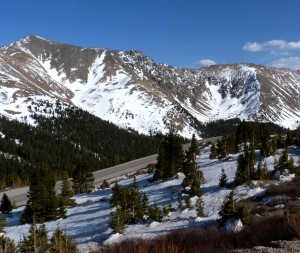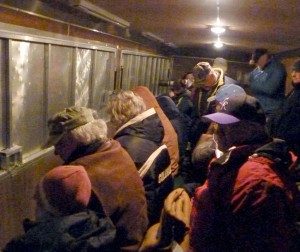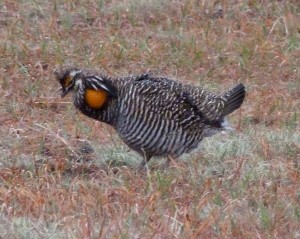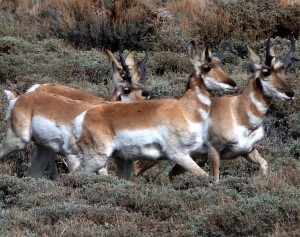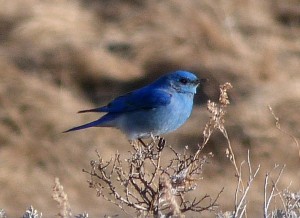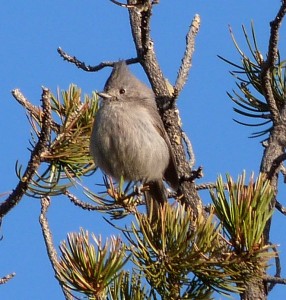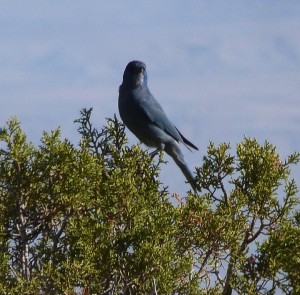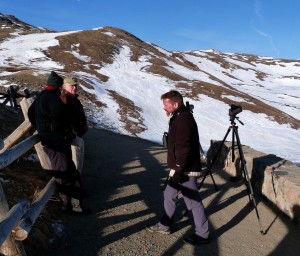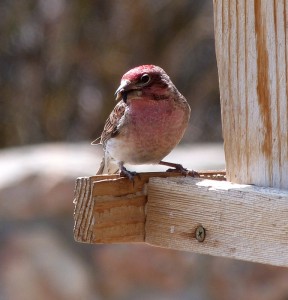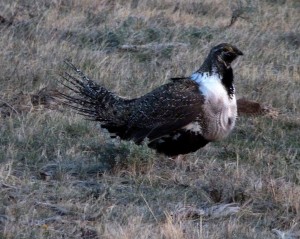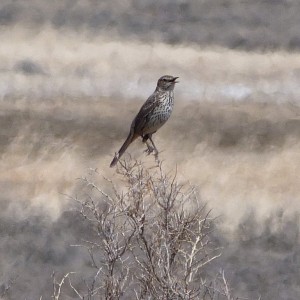Prairie Chickens of Colorado
Who would have thought that driving 2600 miles in 9 days, staying at as many hotels, and waking up several mornings before 4 a.m. could
be so much fun! Trying to see all the Grouse and Prairie Chicken species in the state of Colorado in less than two weeks requires a rather brutal schedule and a healthy constitution, but for anyone who has the desire the rewards can be quite grand! 130 species of beautiful birds, interesting accommodations, good food and seemingly endless scenery that continually takes your breath away! This April, for the first time, I put together a 9-day tour that could possibly include seeing all of the Prairie Chickens, for some long time private clients. We had a very successful and fun trip!
Day I: April 3rd – I got out of Tucson early, only to fly over the grayness above Denver for an extra 45 minutes due to bad weather. Things were really socked in with a small, late season snow storm. After negotiating the rather non-intuitive Denver airport pickup area I found Emily and John and we were headed to points east and a 9 day birding tour of Colorado! The weather was pretty bad, but the birding proved to be good! It was a 170 mile drive from Denver to Wray in the northeastern part of Colorado. Mostly, you are looking at endless expanses of wheat and grazing land but every now and then you see a pocket of remnant habitat or an abandoned old farm with big trees that looked promising. We took a couple of detours that turned out to offer some nice surprises. The best being a Great Horned Owl that John picked up, which was doing his best to hide out in the open!
After checking into the hotel, John and I opted for a quick outing before the required Greater Prairie Chicken orientation to a place called Sand Sage State Fishing Area. In the drizzling rain we picked up a pair of Wood Ducks, Coots, Mallards, Eared Grebe, Ruddy Ducks and Bank Swallows.
The orientation was interesting with a lot of information about the Greater Prairie Chickens and their habitat and dinner that evening at the ‘4th and Main’ restaurant was really good!
Day 2: April 4th – We were up in plenty of time for a cup of coffee and the short trip over to the museum where the bus was just arriving. There was a 30 minute very dark ride in the rain over muddy roads to the lek site, where we all filed off the bus and crawled into the ‘burrito wagon’ viewing trailer, as Josh, our Fish and Wildlife guide, referred to it! Indeed, it is a bit like a ‘roach coach’, or lunch wagon that you see at construction sites, but outfitted far differently inside. There are two long rows of bench seats with cushions and a fair bit of room behind them to set up a scope or to stand.
We waited in the trailer for a little while until Josh felt like it was time to turn out the lights and open up the big serving windows that looked out on the lek. It was dark…I mean really dark, and seeing anything out there at this point was possible only by using some serious imagination! The cloud cover and rain put a damper on the early morning activities of the males who typically come out long before daylight to start their posturing, but even the call of the territory defense were put on hold due to the bad morning weather. Even Josh was a bit surprised at how long it took for the birds to show up, but eventually they did and it was certainly all that I thought it would be! A fantastic display of male birds with upwards of 20 showing up eventually, and quite close!
There were also a couple of Burrowing Owls hanging around the prairie dog village.
After the show we closed up the burrito wagon and headed for a big hearty breakfast at the ranch head-quarters where the lek is situated. It
was fun to see all the old cattle guys serving up breakfast to us birders and how involved many portions of the community are in protecting the Prairie Chickens.
We stayed the previous night at Doc’s B&B, a great old house in the center of town, the owners and manager spent some time talking with us before we packed up and headed off for points south.
It was a fairly long drive to the town of Lamar with one long stop at the Bonny Reservoir that was loaded with waterfowl, even though the water level was quite low. We ended up exploring the margins of the lake which was really not that birdy, but looked like it should be. We did end up seeing a Townsend’s Solitaire but not much else.
Another good stop at Sheridan Lake got us looks at Blue-winged Teal and our first Hooded Mergansers in a pond with a very Blue-billed Ruddy Duck.
I was so happy when I spoke with Norma, our hostess for the Lesser Prairie Chicken lek show the following morning. She informed us that we could sleep in an extra half hour as she didn’t need us to be in Holly until 4:30 a.m., so that meant that we could sleep in until 3:15 a.m.! Heaven! This stuff is insane! We went to bed early at our home for the night in Lamar.
Day 3: April 5 – The 45 minute drive to Holly was a bit dreamlike at that hour, and the patches of fog didn’t help either, but fortunately it was a straight shot and Fred pulled up with the school bus only minutes after our arrival.
I got on the bus as Fred called my name and immediately someone yelled “Oh my God. MacKay!” It was Carolyn Noble, one of my birders from last year’s Gambell trips! She is a wonderful, fun person and I knew it was going to be a great day! Finally, I got to see a lifer with her (since she didn’t get any on Gambell!)
It was a 30 mile drive out to the lek site and I was beginning to wonder if I should count this on my Colorado list or my New Mexico list…it seemed like a long way! Once we got on the ‘dirt’, or what was once dirt, things got far more interesting! The snow and rain of the previous two days had left the so-called road in dubious condition and even Fred was a bit concerned about whether or not we would make it all the way to the lek. The big old school bus did pretty well and Fred was an amazing driver! Several times, I was sure that we would get or were stuck, but every time Fred managed to get that big old yellow beast out of a rut and back on to the road! I was impressed and even more so for a guy who has to be at least 80 years old.
I enjoyed both lek tours a lot, but this one was far more home spun and loose, which certainly had a bit more appeal for me.
The Brits that we had met on the Greater Prairie Chicken trip, Andy and Allen, were with us again for the Lesser, as well as a guy doing a big year.
I would say that we must have done something right that day. We drove out to the lek in extreme fog, but as our luck would have it, the lifted just as the birds were beginning their dance, and remained so just long enough for us to see the birds well, and then it came back in with a vengeance! We had 19 or 20 birds on the lek eventually but once again it took a while to actually get a look at one, probably due to the weather again! We then headed to breakfast! Fred and Norma put on a really great biscuit and gravy breakfast with lively conversation about the rodeo business they used to run!
Then we were off to points north to try and find the Chestnut-collared Longspurs that Andy, the Brit, had clued me in to at a big old water project called Nee Gronda. It is actually a big lake that is one of the few that still actually has water near Lamar.
It was rather amazing, but just as I saw the small ‘puddle’ that he mentioned on the edge of the entrance road, I saw the flash of a white tail that gave away the bird! Of course it did not stick around, so off we went tramping around in a cut-over wheat field slightly smaller than the state of Rhode Island trying to locate this tiny bird! As luck would have it, we got only fly-away looks working the field, and ended up heading back to the car thinking that we would look for it again on our way back out. Just as we got to the car, I heard the chattering call of the longspurs circling overhead and soon located the flock above us. Then one male broke from the group and headed right for us! I thought it might land on the scope! It did not but it did light for a half second next to the puddle, but not long enough for John to get a look at it. Once again, it circled us for a long period of time and eventually landed in the same spot on the edge of the puddle, and this time sat for about 8 seconds, long enough for good looks! We spent another hour in the area and found a pair of Clarkes Grebes, some White Pelicans and a lot of Coots. Then we were off for John Martin Reservoir where we got an Eared Grebe but nothing else new. It was then a long, beautiful drive to La Veta, first across short grasslands and then juniper-Pinyon forests with the fantastic snow covered peaks in the distance, and wonderful looks at numerous Pronghorn Antelope.
The La Veta Inn is a very cool, centrally located spot with a good (not great) restaurant, but really great rooms! As luck would have it, we ran into Carolyn and Charlie again and had dinner with them!
Day 4: April 6th – We had a nice breakfast at the hotel and then headed out to look for the feeders. Carolyn had told us about, one at Bush and Virginia so we went there first. Indeed, there were a lot of feeders but unfortunately most of them had been taken over by the thugs, dozens of Starlings and Red-winged Blackbirds. We did manage to get some Pine Siskins, Cassin’s Finches and another really nice male Yellow-headed Blackbird.
We took a short drive up towards the mountains and by a couple of small lakes that held a lot of Canada Geese and a half dozen or so Common Mergansers. The remainder of the drive, we spent watching for flocks which we found almost immediately. There were a number of ‘pink-sided’ Dark-eyed Juncos and our first Bluebirds of the trip, both Mountain and Western.
Once back in town, we found another set of feeders that had far fewer thugs and some good birds! A beautiful pair of Evening Grosbeaks, the only ones of the trip were picking around in the dirt under the feeder along with a pair of Spotted Towhees.
Then, it was a three hour drive to Gunnison which offered numerous wonderful opportunities to look for birds, but unfortunately was so blown out by the relentless 40 plus mile an hour winds with dust, that we were not really tempted to stop. We did stop at one area that I would have spent a lot of time at if it had not been so windy. Russell Lakes is a collection of maybe 8 or 9 ponds, lakes and wet areas that looked very promising, but with the weather was nearly impossible to bird.
One of the highlights of the drive was the Golden Eagle that flew not 50 yards from the car just at the tops of the trees as we pulled into the outskirts of Gunnison. We got good looks at it before it disappeared behind a small ridge.
We got to Gunnison about 4 p.m. and checked in to the house that we rented at the Wildwood Resort. I had a bit of a scare when the GPS directed us into a small development that looked sort of like the hotel we had reservations in, but fortunately was not! The guy I asked about a room could have been right out of a crystal meth version of Deliverance…but was nice enough to send us in the proper direction! Once we found it, the little house was very comfortable and perfect for us.
After a quick break, we decided to head out to the lek just to make sure that we knew how to get there in the dark tomorrow morning. It was a
beautiful drive out the Gunnison Valley to the Waunita Hot Springs Road and the viewing area. It was still very windy and there was not much to see in the way of birds, but we now knew where would were going in the morning!
We ended up driving all the way up to the hot springs which were another 8 miles up the road and was yet another beautiful drive. We got really more nice looks at Mountain Bluebird and a number of Northern Flickers.
On the way back down I was more concerned about making dinner reservations and the lack of gasoline and was not paying attention to what might be lurking along the side of the road. Just as we were getting to the lek location, two Gunnison Sage Grouse exploded from the ditch on the right side of the road and flew alongside the car for a moment before turning towards the hill and disappearing into the sage brush! Unfortunately, I was the only one who really got a look at all and it was not much of one. We spent a little time trying to find them in the sage brush but they were long gone.
We had dinner at Garlic Mike’s, an Italian place which was really good, before heading back to the house for some much needed rest in preparation for tomorrow.
Day 5: April 7th – A 5 a.m. departure seemed rather civilized after a couple of the other departure times we put ourselves through to see the Prairie Chickens back east! But as we left town with coffee in hand we immediately caught up with two white vans that sure looked like a bird tour group. Indeed, we got to the lek site along with them and set up for the show.
The cars thermometer read 10 degrees when we arrived at the lek! I wondered if this would have any effect on the birds. But the wind had finally subsided and even with the windows down on the car it was still comfortable enough.
It took longer than I thought once again for the birds to show up, and they were a lot farther away than I had hoped. The birds were at least two hundred yards out and the light was really bad. I was watching the clock because I knew from previous reports that the birds had been leaving the lek at about 6:15 a.m., so I knew that we probably only had a short time to get looks at the birds. Sure enough, after only marginal looks I saw one of the birds fly off and I had a sinking feeling that we had seen all that we were going to see today, and the sun was still far below the horizon. Indeed, this ended up being the case.
Trying to make the best of a marginal morning with rather poor looks at the Gunnison Sage Grouse, we went back up the canyon to do some birding with only mild success, but we were rewarded with fine looks at a very large herd of elk.
We had a nice breakfast at the W Café (“Where The Locals Eat”) before going back to the house and packing up for Grand Junction. Well…that is what we thought we were doing. Instead John and I decided to make the most of our time in Gunnison and try a couple of passes to see if we might be able to get into Rosy Finch habitat, certainly the passes in the area are high enough. Our first attempt was for Cumberland Pass which tops out at over 12,000 feet, and if it were open would have great habitat for the finches. Unfortunately after driving up to the town of Pinket we hit the gate that was locked across the road, it would not be open until after Memorial Day, even in this mild winter.
So, then it was off for Crested Butte and an attempt at Keebler Pass. We knew there was a good chance that it would not be open, but that was not the most important part. We needed to check habitat for the finches and that might be available even if the road was not. Unfortunately, we could not get high enough before the road was blocked and we were once again retracing our footsteps back to Gunnison.
We left Gunnison for what ended up being the fourth time at 3 p.m. and made it to Grand Junction by 6 p.m., and got a car wash along the way, much to Emily’s delight!
Day 6: April 8th – John and I went up to Colorado National Monument without Emily this morning, as she chose to sleep in and catch up on some work.
John and I made it up to the higher elevations of the Monument in good time and without trying too hard ran into a small flock of Pinyon Jays right off the bat. Even better, two of them ended up posing for us and giving great life looks for John. Later, we came across a lovely Peregrine Falcon sitting over the road in a dead tree limb. We walked to within a few yards of him for photos and he was not the least bit concerned.
We stopped for a wonderful Easter Sunday lunch in the Palisades wine country on our way to Craig. Our first big birding stop was at the big pond on the edge of Meeker where we got our first looks at a couple of Sandhill Cranes.
Once we got to Craig we decided to do a cursory research trip out to find the County Road 80 leks so that we knew where to go in the dark of
the following morning. We spent some time birding in the oak scrub at the top of the hill where Dusky Grouse are often seen. While walking down the road, John rather nonchalantly mentioned that he had just seen a grouse fly by. We spent some time trying to find another one but to no avail, so we headed back to Craig for the evening.
Day 7: April 9th – Once again we were up at o’dark thirty and on our way to the lek on County Road 80. Yesterday afternoon’s scouting trip had left me with more questions than answers in some regards, but at least I knew where the Dusky Grouse spot was, which would be the more important bird of the morning.
As we crept up the gravel road in the dark, I was certain that my eyes were playing tricks on me when I saw what I thought was the head of a dead deer in the middle of the road, then it turned profile and I realized that it was actually a Dusky Grouse roosting on the middle of the road! Best yet, it never flew! It just sauntered off the left side of the road and up into the scrub and we all got cracking looks at it! Onward we went and within seconds, there was a second Dusky Grouse in the road that gave us another great view!
Satisfied with the Dusky looks, we went off to try our luck with the Greater Sage Grouse spots that were not well described in any information that I had. After 30 minutes of hearing nothing I pulled the plug and decided just to drive and listen. This turned out to be the right thing to do. At the second cattle guard, I stopped long enough to hear the cackling calls of Sharp-tailed Grouse not far from the road and quickly located them. There were at least 6 of them courting a couple of females in the rather tall grass.
While enjoying the amazing Sharp-tailed Grouse show, a Greater Sage Grouse flew over our heads at a rather high elevation, and although we were thoroughly impressed with the bird’s ability to fly so incredibly well and far, it was not a great view at all! But it was, indeed, impressive to see that big rather non-aerodynamic bird travel such a great distance!
On our way back towards the highway a couple more Dusky Grouse flew over the road, and eventually we ran into at least another 4 Dusky Grouse, some of them sunning themselves in trees right out in the open for extended periods of time! This is a bird that is frequently the one that people miss on this tour, as it is known to be difficult to see. For us, it ended up being the most common bird of the morning!
We did make one detour on our way to Steamboat Springs to check out the location of another Sharp-tailed Grouse Lek, mostly for future reference, and ended up not seeing any more grouse, but we did get good looks at 7 Sandhill Cranes. In Steamboat we stopped for breakfast at Winona’s Café.
The rest of the morning found us driving on towards Loveland Pass where we made our first of three attempts for White-tailed Ptarmigan in the dwarf spruce forest and tundra at nearly 12,000 feet! Although incredibly beautiful, Loveland Pass is not the birdiest area in Colorado, so while you’re looking for the Ptarmigan you don’t need to be bothered by a whole lot of other birds flying around. You are lucky to find a robin now and then! After a couple of hours, we gave up and headed on to Georgetown where we checked into the hotel and dropped off Emily. John and I went back up to the pass for a couple of hours of staring at the dwarf spruce trees with our new friends, the Brits Andy and Allen, who were also not finding birds!
After once again not finding the Ptarmigan, we headed back to Georgetown and dinner with Andy, Allen and Janet at the Euro Café.
Day 8: April 10th – John and I decided to make one last attempt for the Ptarmigan this morning and I am glad that we did. Andy and Allen went up super early and were still there looking when we got there at about 6:45 a.m. I have to admit that I was a bit down on the bird after about an hour of looking and listening to the Brits complain about how hard this bird was to get! Then, as if the black curtain of despair was lifted, Andy nearly screamed out that he had found two of them! It was a fabulous moment! After a successful Ptarmigan moment, we went back for breakfast at the Mountain Buzz and the Brits headed off for the airport in Denver; a much happier drive, indeed, with the white birds under their belts (and ours)! For us, it was off to the north again and the remote mountain town of Walden. Along the way, we stopped outside of Winter Park to scan a pond that was full of ducks. We picked up Lesser Scaup in spades and a singing Song Sparrow was a bonus.
Just outside of Walden we saw a sign for the Arapaho Valley National Wildlife Refuge and a wildlife viewing driving tour, so we decided to go
ahead and do it. It was a wonderful drive with a number of ponds that were also full of waterfowl. About half way through the 6 miles, we ran into a Singing Sage Thrasher that gave us wonderful views.
Being a bit ahead of schedule, we decide to head on up to the Moose Visitor Center in the State Forest State Park where I knew there were some good feeders. There were lots of birds, more than we had seen in a couple of days, but most were Red-winged Blackbirds. We did, however, get fine looks at Cassin’s Finches and a Pine Grosbeak was a bit of a surprise this late in the season.
Then we were off to scout the Greater Sage Grouse lek south of Walden, and I am glad that we did. It would have been a bit funky getting there in the dark and trying to figure out the directions. Even as it was, I was still a bit unsure if I was in the right spot. We then did a loop back to town via the Delaney Butte Lakes and on the way found a Common Loon and three Western Grebes. We had dinner at our hotel, the Antlers Inn, and then headed off for an early sleep.
Day 9: April 11th - John and I were out the door and off to the public swimming pool at 5 a.m. to meet up with Heidi, a woman that works at the Antlers Inn, who had offered to make us coffee while she opened up the pool for ‘free swim’. She was only a few minutes late, but we were still quite grateful to her for making us coffee as there was no other place open in town.
It was a balmy 30 degrees as we headed off to the lek in the dark, excited about the possibility of seeing the last chicken of the trip, the Greater Sage Grouse. We arrived at the perfect time and waited to hear something or get a glimpse of a flying bird in the dawn light. Soon after a car came up behind us and it was another birder looking for grouse and he asked us if we were in the right place. Unfortunately, we were not exactly sure and he opted to stay with us and wait! Within minutes, I saw a bird fly toward the road a couple hundred yards in front of us. Scanning the short grass with my binoculars in the area that I thought the bird had landed I soon recognized the form of several Greater Sage Grouse standing tall ahead of us. We decided to move up to the spot and the birds seemed not to care at all! We got within 30 yards of one that gave us a spectacular show! By the end of the hour or so that we were there, we counted 19 males on the lek and no females.
We got back to the hotel and met up with Emily for breakfast before driving on to Cameron Pass and a date with a Three-toed Woodpecker. I was surprised at how quickly a female responded to just a short blast of tape, coming in very closely! We spent a little time watching her before she got a bit shy and hid on the backside of a tree. Fortunately, almost immediately a male flew in even closer and we got excellent close up views of him. After making a few more stops at even higher elevations, including the very top of Cameron Pass, we eventually ended up seeing at least 7 Three-toed Woodpeckers.
We decided to hightail it out of the mountains and out to the Pawnee Grasslands where we hoped to find a McCown’s Longspur and possibly a Mountain Plover, both birds we had missed on the first couple of days of the trip. The drive was fairly easy and we were birding good habitat for both species within two hours. We drove about 75 miles of dirt county roads scanning and stopping in good spots. Eventually we came to a dry crossing that was an area of serious target practice for locals. There were hundreds of broken clay pigeons and thousands of spent ammo rounds throughout the area. But there were also birds! More than we had seen in the grasslands thus far, and eventually I managed to pull out one McCown’s Longspur mixed in with a few Horned Larks, but that would be the only one we would find the entire afternoon! The Mountain Plover never materialized and eventually we were forced to abandon the search and start heading to the airport.
We got to Denver International in plenty of time for my flight and just in time for a tornado warning that shut down the airport and had people heading for the shelters! It was interesting to see how different people reacted to the possible situation! In the end, it was canceled and everyone was fine.
It was a truly great trip! Thanks, Emily and John, for being such great company!
After having done this trip, I am evaluating the route and some of the other logistical details as I plan to offer this a trip for next spring. Look for more details on the website soon.
More photos are at this link http://www.flickr.com/photos/birdgeek/sets/72157629941621671/
